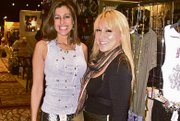More Venues and More Shows Mean Greater Risks and Rewards for Showroom Owners
Independent showroom owners thinking about expansion may take some advice from those who have been there: Do some homework first.
Running multiple venues can reap big rewards or it can be draining, as wholesaler Lynne Andresevic found out.
Andresevic, owner of the Crayola Sisters showroom in Los Angeles’ California Market Center, last October shuttered her Dallas Market Center showroom after more than 10 years in Dallas.
“The traffic was not there anymore,” she said. Crayola Sisters remains open in the CMC, carrying updated and contemporary lines such as Hanna, Cordelia, Oleana and Ulf Anderson.
Times are changing for showroom operators as the tradeshow landscape continues to grow and technology makes it easier to reach the buyer. It’s very different from when Andresevic first expanded to Dallas.
“When I started, it was almost automatic,” she said. “People would just walk in and buy without an appointment.”
The veteran wholesaler said these days she catches up with her Southwest accounts at the growing Women’s Wear in Nevada (WWIN) show, held in Las Vegas twice a year. The CALA show in San Francisco; the CMC markets in Los Angeles or; one of several shows in New York.
Still, the past three years have been tough for Andresevic. While her Los Angeles showroom business has tripled over the past year, her Dallas showroom struggled for three years before she decided to shutter it.
But even as the Dallas market has dried up for some, it has opened up new opportunities for others. The city is now home to two apparel wholesale marts: the longstanding Dallas Market Center and the 3-year-old Fashion Industry Gallery (FIG), located near the Neiman Marcus flagship.
When FIG opened, CMC showroom owner Liza Stewart saw it as an opportunity to expand.
“I saw the Southwest as a viable market,” said Stewart. “It doesn’t have the volume of the West Coast, but it’s a great territory because of its abundance of specialty stores.”
Both Stewart and Andresevic said expanding in Dallas requires a lot of legwork and planning.
“You have to do your homework,” Andresevic advised. “There are different patterns in the economy. Hurricane Katrina, for example, had an enormous impact on the Southwest. There were [stores in] entire states that didn’t shop for a long time, but, on the other hand, there are big pockets of prosperity.”
Both Andresevic and Stewart decided to staff their Dallas and Los Angeles showrooms full time rather than open on an appointment-only or show-only basis.
“You never know who is going to come in,” said Andresevic. “I’ve had buyers from Nordstrom and Harari walk in at 4 p.m. on a Friday. If people know you are open, they will come.”
Added Stewart: “You also have to know your market and the geography. Trends still start on the West and East coasts. We see buyers from the Southwest in L.A. and some from the Midwest in Dallas, so it’s a balancing act. The bottom line is you have to keep your relationships strong, and [staffing] is important.”
Andresevic agreed: “The buyers like to see the same faces all the time.”
Consistency and customer service
Another veteran showroom owner, Suzanne Lerner, owner of Lerner et Cie, based in The New Mart in Los Angeles, has been a stalwart over the past 20 years, having grown the company’s presence to Dallas, Atlanta and New York. The keys to her success have been carrying consistently performing lines––including Michael Stars, Laurie B. and G1––and providing a high level of customer service.
“Suzanne has been great at establishing and maintaining long relationships that have lasted years and years,” said Lerner Sales Manager Kristen Tiberg.
To keep up the service level, there’s a lot of sacrifice of personal time because of the travel involved, said the reps. Because of Lerner’s diversified business, she is often on the road. Andresevic, who now lives in San Francisco, has forged a number of new accounts in that territory but is regularly jetting between Northern and Southern California as well as to Las Vegas and New York.
Stewart also attends all of FIG’s markets as well as the New York, Las Vegas and San Francisco shows. She also participates in StyleMax in Chicago.
“There’s kind of an over-saturation of trade shows now,” Stewart said, adding that although more shows means more work for her and her team, they also provide more opportunities to build sales and strengthen brands.
Expansion also means finding the right location, and that can sometimes be difficult, said reps. In Los Angeles, the key contemporary showcases are either sold out or are nearly sold out. The New Mart has a waiting list, and the Cooper Design Space is near capacity. The Gerry Building is near capacity, but several tenants have recently departed. The California Market Center has space but is tightening up on key floors. In Dallas, space at the FIG and Dallas Market Center is open but in demand.
And real estate is not cheap. One contemporaryshowroom owner who requested anonymity said she has seen a number of ventures fail due to poor planning and unexpected costs.
“You almost have to have at least $200,000 to cover yourself for the first year. It’s not easy,” she said.






















